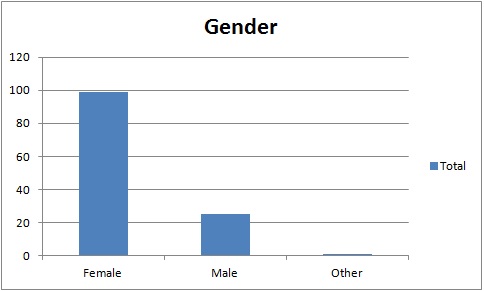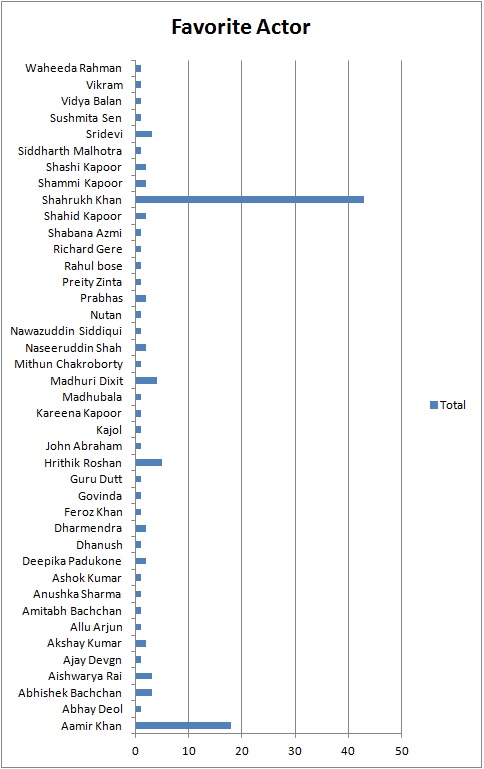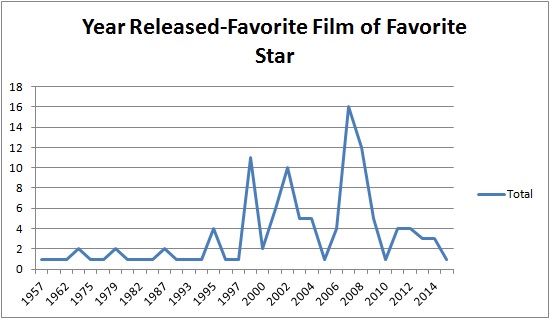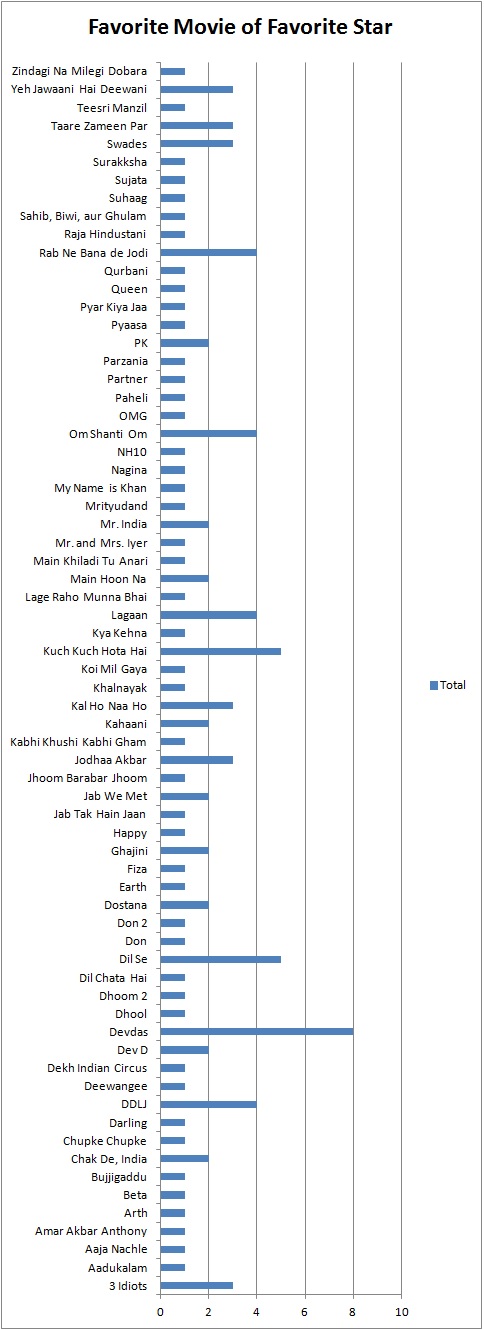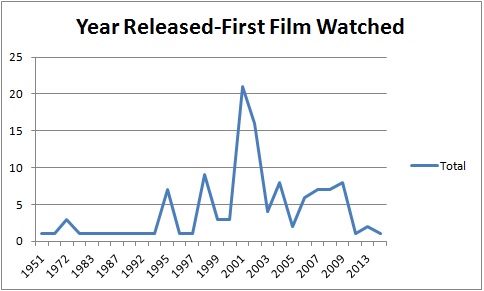Check out my blog at dontcallitbollywood.com
How old are you?
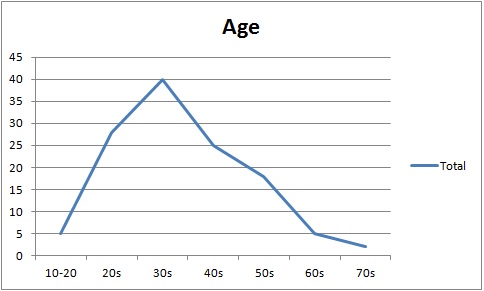 As you can see, the majority by far of fans are in their mid-thirties. This lines up with several other data points. Most importantly, those who are in their thirties today would have been in their late teens and early twenties at the turn of the century. After the film industry gained industrial status in 1999, and following the international success of DDLJ, Kuch Kuch Hota Hai, K3G, and others, Indian filmmakers truly went after the international market with Lagaan and Devdas in 2001 and 2000. Moreover, after the burst of international immigration from India the 60s, 70s, and 80s, the first generation of westerners to grow up with large numbers of South Asian contemporaries would come of age in the late nineties. As young adults in that era, today’s thirty year olds would have been at a transition point in their lives, receptive to new interests and hobbies, and already more familiar with South Asian culture than the previous generation when the first big promotional push for Indian film happened (not to mention the technological changes in DVDs, the internet, etc. which occurred in the same era and supported this push).
As you can see, the majority by far of fans are in their mid-thirties. This lines up with several other data points. Most importantly, those who are in their thirties today would have been in their late teens and early twenties at the turn of the century. After the film industry gained industrial status in 1999, and following the international success of DDLJ, Kuch Kuch Hota Hai, K3G, and others, Indian filmmakers truly went after the international market with Lagaan and Devdas in 2001 and 2000. Moreover, after the burst of international immigration from India the 60s, 70s, and 80s, the first generation of westerners to grow up with large numbers of South Asian contemporaries would come of age in the late nineties. As young adults in that era, today’s thirty year olds would have been at a transition point in their lives, receptive to new interests and hobbies, and already more familiar with South Asian culture than the previous generation when the first big promotional push for Indian film happened (not to mention the technological changes in DVDs, the internet, etc. which occurred in the same era and supported this push).
This is not to say that fandom ends with the thirty year old generation. As you can see, the number of respondents rises steeply to that point and drops off slowly. There are already 25 respondents around the age of twenty, the fandom will not disappear. Moreover, it is a slow decline on the other side. There were several respondents in their forties and fifties, it is only around age 60 that there is a definite decrease. Based on my interviews and further interactions with respondents, what might be more accurate to say is that since at least 2000 there has been a growing number of people discovering Indian film, most of them while in their early twenties, and that their interest remains steady, peaking often around age thirty before life and other responsibilities causes them to step back. It is possible that the same survey, conducted ten years from now, would find the same pattern as today’s twenty year olds have grown into rabid fans by age thirty, while today’s rabid fans are slowly losing interest as other aspects of life take hold.
What Gender are You?
Again, this should come as no surprise, but women dominate the international non-Indian fandom. This is closely related to exactly which genre of films this fandom finds most appealing. The post-2000s Shahrukh Khan vehicles are aimed at a female and family audience. In contrast, the films of Amitabh Bachchan from the 70s, or the films of Salman Khan currently, are aimed at a male audience. In terms of internet fandom in general, as I am sure we are all aware, misogynistic communities are a real threat. Bollywood is no exception, it you read the comments on youtube trailers or Indian newsites, there are constant angry comments and trolling.
However, within the non-Indian fan community, it is a “safe” space. Primarily female, with female concerns being the main talking points (character arcs for female characters, attractiveness of male stars, etc.), the most active and engaged fans, the ones who would respond to my survey, tend to be female. This is not to say that there are not male fans as well who think deeply on these topics, but they are ones who are able to surpass traditional gender roles, or branch out from the standardized fandom of Shahrukh/2000s films and instead find the more obscure (for a Western audience) male oriented films of the type mentioned above.
Who is your favorite actor?
As you can see, it’s Shahrukh by a mile! Although, again, there is a surprising amount of diversity in the other selections, including several regional stars and stars from previous eras. The choice of Shahrukh, followed by Aamir, actually indicates the unity of the overseas audience. Indian heritage or not, Shahrukh rules all. While in India, he is still challenged by Salman and Aamir, in the NRI audience he has long been the most popular choice. His star brand is calculated to appeal to the global market, whether of Indian heritage or not.
In addition, he is also the most appealing star to the female market. As has been discussed by many authors, from the beginning Shahrukh has chosen to place himself in female spaces, whether it is the kitchen in DDLJ or the bathtub in Lux soap ads. He has allied himself with the female gender and has reaped his reward in popularity among women, which would translate into popularity among the primarily female respondents to this survey.
What are your current favorite movies?
The concept of the western audience is disputed by the graph below which shows the years released of respondents current favorite films of their favorite actors (many respondents had multiple choices here, for the purposes of this graph I included the first named, but I will certainly be giving proper weight to each one when I discuss attitudes and tastes in more detail in my final project).
As you can see, while the majority of the films are still post-2000, they include many recent releases indicating an expanding and growing interest among fans, as well as a variety of releases from previous decades going all the way back to the 1950s golden age. A more detailed graph, detailing the exact titles of films, is below.
As you can see, there is much greater diversity on this graph than on the one indicating the first film watched. There are both more films selected in general, and the dominance of the most popular selections is much less.
What were the first movies you saw?
.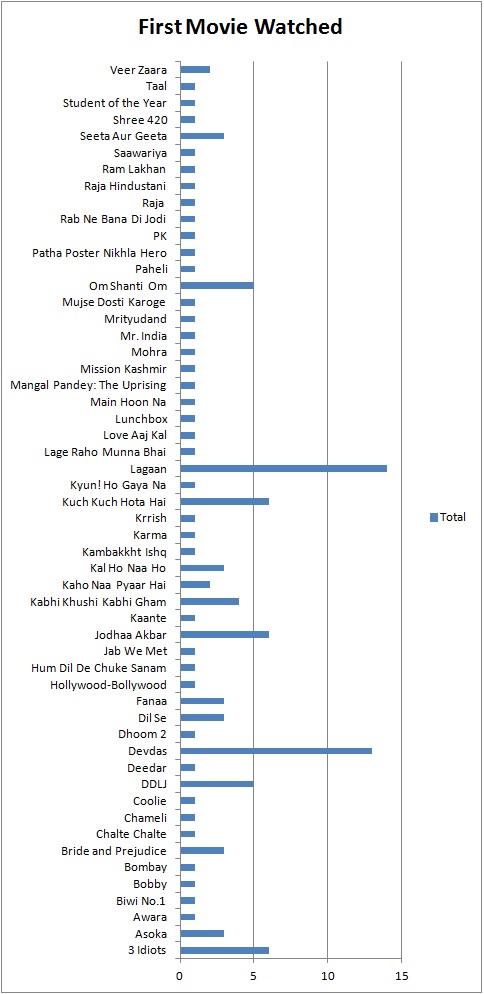 As mentioned previously, Indian film gained an enormous boost at the turn of the century, which is obvious from this graph and the one below. The films of the early 2000s tend to be easier “entry” films for an unfamiliar viewer. They were aimed at the growing diaspora audience, and therefore included fewer complex social and historical allusions than earlier films. In addition, they tended to be more technically and narratively accessible. Everything from the quality of the film stock to the depiction of religion was designed to be more aligned with Western standards.
As mentioned previously, Indian film gained an enormous boost at the turn of the century, which is obvious from this graph and the one below. The films of the early 2000s tend to be easier “entry” films for an unfamiliar viewer. They were aimed at the growing diaspora audience, and therefore included fewer complex social and historical allusions than earlier films. In addition, they tended to be more technically and narratively accessible. Everything from the quality of the film stock to the depiction of religion was designed to be more aligned with Western standards.
How educated are Bollywood fans in general?
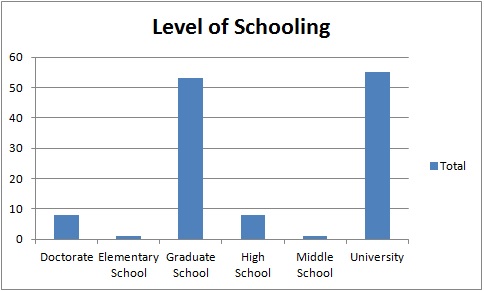 As you can see from this graph, the vast majority of my respondents were highly educated. As mentioned above, this is no doubt to some degree related to the types of websites and areas of the internet where I sought responses. In addition, as South Asians have a much higher rate of higher education, the experience of attending college would serve in most countries to force a person into contact with friends and acquaintances of South Asian heritage and add to their familiarity and comfort with Indian film
As you can see from this graph, the vast majority of my respondents were highly educated. As mentioned above, this is no doubt to some degree related to the types of websites and areas of the internet where I sought responses. In addition, as South Asians have a much higher rate of higher education, the experience of attending college would serve in most countries to force a person into contact with friends and acquaintances of South Asian heritage and add to their familiarity and comfort with Indian film
What were the most common ethnicities/national identities?
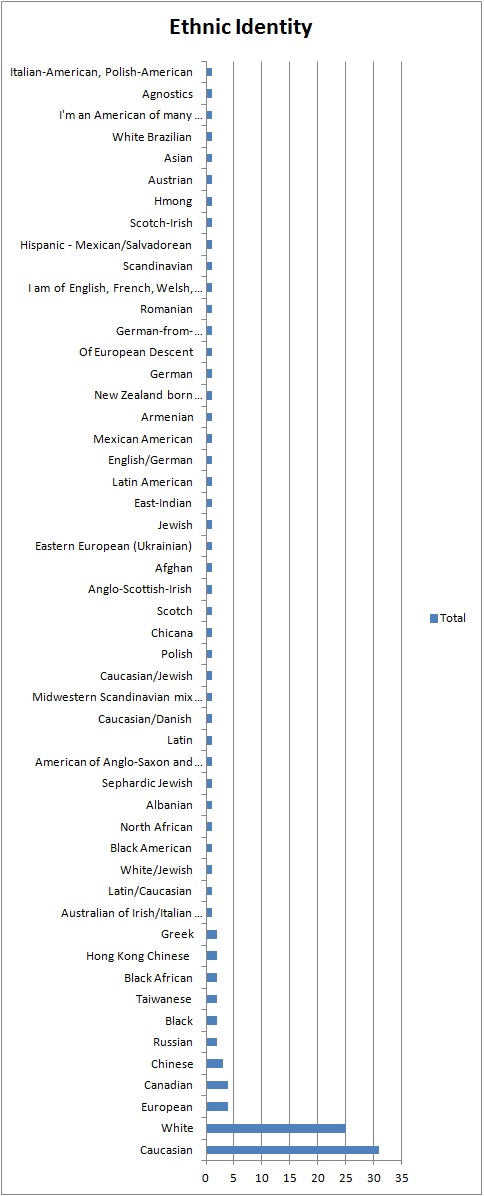 There were many many many different ethnicities cited. I tried to combine them where it was plausible in order to make this graph easier to read, but I also did not want to risk removing any important data, so it is very long and complex. By far the most common ethnicity is white/caucasian. Many of the other categories could easily also be interpreted as caucasian or white. This directly relates to the graph below which lists national identities.
There were many many many different ethnicities cited. I tried to combine them where it was plausible in order to make this graph easier to read, but I also did not want to risk removing any important data, so it is very long and complex. By far the most common ethnicity is white/caucasian. Many of the other categories could easily also be interpreted as caucasian or white. This directly relates to the graph below which lists national identities. 
Many researchers over the course of many decades have confirmed the popularity of Indian film in Russia, Nigeria, Saudi Arabia, Germany, and various other countries. However, my research found few respondents from those areas, either in their current nationality or in their ethnic identity. In order to explain this contradiction, I turned to the more detailed responses I requested from those who do live in those areas. It appears that, while there is a large and old fan tradition, it is one that deals with the films unquestioningly and without analysis. In order to find a community that will discuss the films in an analytical and detailed manner, these few fans who responded were forced to turn online. Therefore, my conclusion is that for the majority of the fans from those countries who have less of an intellectual relationship with the films, there is no need to search out an online community as they have a ready-made community in the “real” world. And therefore, they did not see and respond to this survey and are not present in my results.
How many fans have kids?
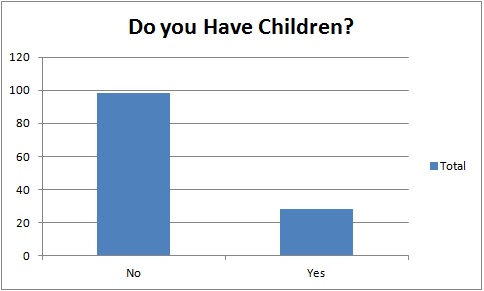 This graph is closely tied with the previous one. As mentioned above, many respondents indicated in the longer answers that the responsibilities they gained later in life, including children, forced them to spend less time on their fandom. This would also lead to the conclusion that fewer fans with children would have the time to complete my survey, or even stay current with the websites where it was posted.
This graph is closely tied with the previous one. As mentioned above, many respondents indicated in the longer answers that the responsibilities they gained later in life, including children, forced them to spend less time on their fandom. This would also lead to the conclusion that fewer fans with children would have the time to complete my survey, or even stay current with the websites where it was posted.
However, there is another possibility. Researchers have found among Indian heritage Indian film fans, that watching the movies becomes a family activity. Mothers will share them with their children, often using the opportunity to pass on family values. They will also become a bonding experience between in-laws, sisters, etc. Especially during a time when women are tied to the home due to young children, the films provide a way to bond and interact with fellow caregivers without requiring leaving the home. There has been no similar research done on non-Indian fans (because not that many people have studied them), but the interviews and longer exchanges I have had indicated that many fans with children have at least attempted to share their interest, with some success. Therefore, it is also possible that there were fewer respondents to my survey with children because they no longer need to participate in an online film community as they have found one at home.
Entire list of results!!!
 As you can see, the majority by far of fans are in their mid-thirties. This lines up with several other data points. Most importantly, those who are in their thirties today would have been in their late teens and early twenties at the turn of the century. After the film industry gained industrial status in 1999, and following the international success of DDLJ, Kuch Kuch Hota Hai, K3G, and others, Indian filmmakers truly went after the international market with Lagaan and Devdas in 2001 and 2000. Moreover, after the burst of international immigration from India the 60s, 70s, and 80s, the first generation of westerners to grow up with large numbers of South Asian contemporaries would come of age in the late nineties. As young adults in that era, today’s thirty year olds would have been at a transition point in their lives, receptive to new interests and hobbies, and already more familiar with South Asian culture than the previous generation when the first big promotional push for Indian film happened (not to mention the technological changes in DVDs, the internet, etc. which occurred in the same era and supported this push).
As you can see, the majority by far of fans are in their mid-thirties. This lines up with several other data points. Most importantly, those who are in their thirties today would have been in their late teens and early twenties at the turn of the century. After the film industry gained industrial status in 1999, and following the international success of DDLJ, Kuch Kuch Hota Hai, K3G, and others, Indian filmmakers truly went after the international market with Lagaan and Devdas in 2001 and 2000. Moreover, after the burst of international immigration from India the 60s, 70s, and 80s, the first generation of westerners to grow up with large numbers of South Asian contemporaries would come of age in the late nineties. As young adults in that era, today’s thirty year olds would have been at a transition point in their lives, receptive to new interests and hobbies, and already more familiar with South Asian culture than the previous generation when the first big promotional push for Indian film happened (not to mention the technological changes in DVDs, the internet, etc. which occurred in the same era and supported this push).
This is not to say that fandom ends with the thirty year old generation. As you can see, the number of respondents rises steeply to that point and drops off slowly. There are already 25 respondents around the age of twenty, the fandom will not disappear. Moreover, it is a slow decline on the other side. There were several respondents in their forties and fifties, it is only around age 60 that there is a definite decrease. Based on my interviews and further interactions with respondents, what might be more accurate to say is that since at least 2000 there has been a growing number of people discovering Indian film, most of them while in their early twenties, and that their interest remains steady, peaking often around age thirty before life and other responsibilities causes them to step back. It is possible that the same survey, conducted ten years from now, would find the same pattern as today’s twenty year olds have grown into rabid fans by age thirty, while today’s rabid fans are slowly losing interest as other aspects of life take hold.
 This graph is closely tied with the previous one. As mentioned above, many respondents indicated in the longer answers that the responsibilities they gained later in life, including children, forced them to spend less time on their fandom. This would also lead to the conclusion that fewer fans with children would have the time to complete my survey, or even stay current with the websites where it was posted.
This graph is closely tied with the previous one. As mentioned above, many respondents indicated in the longer answers that the responsibilities they gained later in life, including children, forced them to spend less time on their fandom. This would also lead to the conclusion that fewer fans with children would have the time to complete my survey, or even stay current with the websites where it was posted.
However, there is another possibility. Researchers have found among Indian heritage Indian film fans, that watching the movies becomes a family activity. Mothers will share them with their children, often using the opportunity to pass on family values. They will also become a bonding experience between in-laws, sisters, etc. Especially during a time when women are tied to the home due to young children, the films provide a way to bond and interact with fellow caregivers without requiring leaving the home. There has been no similar research done on non-Indian fans (because not that many people have studied them), but the interviews and longer exchanges I have had indicated that many fans with children have at least attempted to share their interest, with some success. Therefore, it is also possible that there were fewer respondents to my survey with children because they no longer need to participate in an online film community as they have found one at home.
 There were many many many different ethnicities cited. I tried to combine them where it was plausible in order to make this graph easier to read, but I also did not want to risk removing any important data, so it is very long and complex. By far the most common ethnicity is white/caucasian. Many of the other categories could easily also be interpreted as caucasian or white. This directly relates to the graph below which lists national identities.
There were many many many different ethnicities cited. I tried to combine them where it was plausible in order to make this graph easier to read, but I also did not want to risk removing any important data, so it is very long and complex. By far the most common ethnicity is white/caucasian. Many of the other categories could easily also be interpreted as caucasian or white. This directly relates to the graph below which lists national identities. 
Many researchers over the course of many decades have confirmed the popularity of Indian film in Russia, Nigeria, Saudi Arabia, Germany, and various other countries. However, my research found few respondents from those areas, either in their current nationality or in their ethnic identity. In order to explain this contradiction, I turned to the more detailed responses I requested from those who do live in those areas. It appears that, while there is a large and old fan tradition, it is one that deals with the films unquestioningly and without analysis. In order to find a community that will discuss the films in an analytical and detailed manner, these few fans who responded were forced to turn online. Therefore, my conclusion is that for the majority of the fans from those countries who have less of an intellectual relationship with the films, there is no need to search out an online community as they have a ready-made community in the “real” world. And therefore, they did not see and respond to this survey and are not present in my results.
 As you can see from this graph, the vast majority of my respondents were highly educated. As mentioned above, this is no doubt to some degree related to the types of websites and areas of the internet where I sought responses. In addition, as South Asians have a much higher rate of higher education, the experience of attending college would serve in most countries to force a person into contact with friends and acquaintances of South Asian heritage and add to their familiarity and comfort with Indian film
As you can see from this graph, the vast majority of my respondents were highly educated. As mentioned above, this is no doubt to some degree related to the types of websites and areas of the internet where I sought responses. In addition, as South Asians have a much higher rate of higher education, the experience of attending college would serve in most countries to force a person into contact with friends and acquaintances of South Asian heritage and add to their familiarity and comfort with Indian film
. As mentioned previously, Indian film gained an enormous boost at the turn of the century, which is obvious from this graph and the one below. The films of the early 2000s tend to be easier “entry” films for an unfamiliar viewer. They were aimed at the growing diaspora audience, and therefore included fewer complex social and historical allusions than earlier films. In addition, they tended to be more technically and narratively accessible. Everything from the quality of the film stock to the depiction of religion was designed to be more aligned with Western standards.
As mentioned previously, Indian film gained an enormous boost at the turn of the century, which is obvious from this graph and the one below. The films of the early 2000s tend to be easier “entry” films for an unfamiliar viewer. They were aimed at the growing diaspora audience, and therefore included fewer complex social and historical allusions than earlier films. In addition, they tended to be more technically and narratively accessible. Everything from the quality of the film stock to the depiction of religion was designed to be more aligned with Western standards.
However, this concept of the western audience is disputed by the graph below which shows the years released of respondents current favorite films of their favorite actors (many respondents had multiple choices here, for the purposes of this graph I included the first named, but I will certainly be giving proper weight to each one when I discuss attitudes and tastes in more detail in my final project).
As you can see, while the majority of the films are still post-2000, they include many recent releases indicating an expanding and growing interest among fans, as well as a variety of releases from previous decades going all the way back to the 1950s golden age. A more detailed graph, detailing the exact titles of films, is below.
As you can see, there is much greater diversity on this graph than on the previous one. There are both more films selected in general, and the dominance of the most popular selections is much less.
As you can see, it’s Shahrukh by a mile! Although, again, there is a surprising amount of diversity in the other selections, including several regional stars and stars from previous eras. The choice of Shahrukh, followed by Aamir, actually indicates the unity of the overseas audience. Indian heritage or not, Shahrukh rules all. While in India, he is still challenged by Salman and Aamir, in the NRI audience he has long been the most popular choice. His star brand is calculated to appeal to the global market, whether of Indian heritage or not.
In addition, he is also the most appealing star to the female market. As has been discussed by many authors, from the beginning Shahrukh has chosen to place himself in female spaces, whether it is the kitchen in DDLJ or the bathtub in Lux soap ads. He has allied himself with the female gender and has reaped his reward in popularity among women, which would translate into popularity among the primarily female respondents to this survey.
Again, this should come as no surprise, but women dominate the international non-Indian fandom. This is closely related to exactly which genre of films this fandom finds most appealing. The post-2000s Shahrukh Khan vehicles are aimed at a female and family audience. In contrast, the films of Amitabh Bachchan from the 70s, or the films of Salman Khan currently, are aimed at a male audience. In terms of internet fandom in general, as I am sure we are all aware, misogynistic communities are a real threat. Bollywood is no exception, it you read the comments on youtube trailers or Indian newsites, there are constant angry comments and trolling.
However, within the non-Indian fan community, it is a “safe” space. Primarily female, with female concerns being the main talking points (character arcs for female characters, attractiveness of male stars, etc.), the most active and engaged fans, the ones who would respond to my survey, tend to be female. This is not to say that there are not male fans as well who think deeply on these topics, but they are ones who are able to surpass traditional gender roles, or branch out from the standardized fandom of Shahrukh/2000s films and instead find the more obscure (for a Western audience) male oriented films of the type mentioned above.
